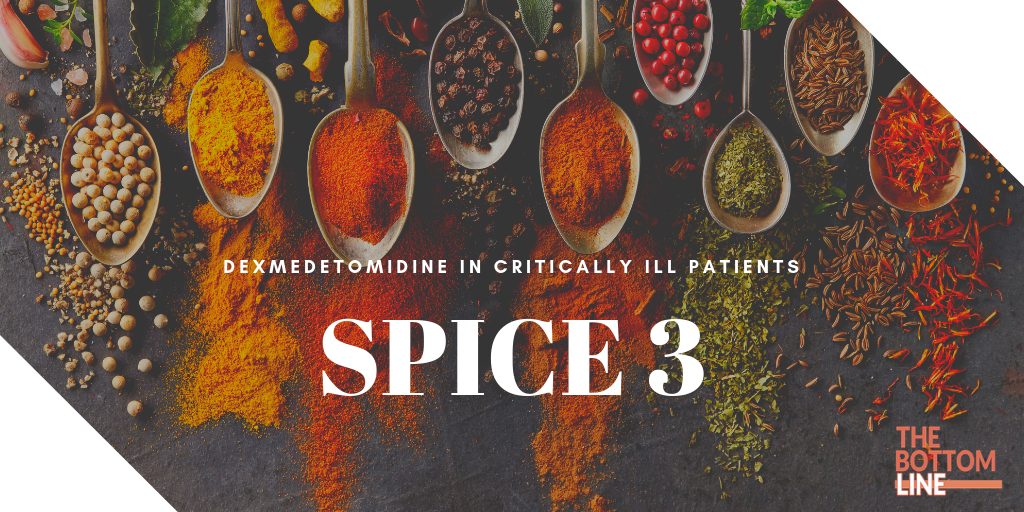SPICE III

Early Sedation with Dexmedetomidine in Critically Ill Patients
Shehabi, Y. NEJM. May 19 2019. doi:10.1056/NEJMoa1904710
Clinical Question
- In ventilated, critically ill patients, does the use of dexmedetomidine as the primary sedative agent compared with usual sedative agents effect 90 day mortality?
Background
- The ideal agent to keep patients comfortable and safe whilst ventilated in ICU is not known
- There are several options for sedation including opioids, benzodiazepines, propofol and centrally-acting alpha-agonists such as dexmedetomidine or clonidine
- The balance of safety and harm is always the priority in the ICU population
- Previous studies examining dexmedetomidine have suggested shorter times to extubation and a higher number of days without coma or delirium
- However, there are limitations to these trials, including small sample sizes, underpowering to detect clinically meaningful outcomes and inconsistency with methodology
- The MIDEX-PRODEX trial examined the feasibility of using propofol or midazolam vs dexmedetomidine to achieve desired Richmond Agitation Sedation Scale (RASS) levels
- Skrobik’s trial used low dose nocturnal dexmedetomidine and showed a reduced incidence of delirium
- The DAHLIA trial supported the use of dexmedetomidine when used in delirious patients as a means of earlier liberation from the ventilator
Design
- Randomised Controlled Trial with 1:1 ratio
- Allocation concealment achieved via a computerised randomisation program
- Modified Intention to Treat Analysis (excluding those who withdrew consent and where primary outcome was not known); all but 2.4% of patients
- Unblinded
- Variable block sized randomisation; achieves balance in the allocation of participants and the allocation is difficult to predict due to the variable block size
- Stratified to site and presence of sepsis
- 90% power to detect a 4.5% difference in mortality with 4000 patients (allowing a 5% loss to follow-up)
- 6 prespecified subgroups
Setting
- 74 ICUs in 8 countries (Australia, Ireland, Italy, Malaysia, New Zealand, Saudi Arabia, Switzerland, UK)
- November 2013 to February 2018
Population
- Inclusion: ICU patients receiving mechanical ventilation, expected to continue to at least the day after next and needing sedation for safety and/or comfort.
- Exclusion:
- <18 years
- Ventilation > 12 hours before enrolment
- Acute primary brain injury
- 29502 patients were screened, with 4000 patients randomised, 2001 to receive dexmedetomidine and 1999 to receive usual care
- 47 patients in the dexmedetomidine group and 35 in the usual group did not give consent, and 6 more in the dexmedetomidine group and 8 in the usual care group were lost to follow-up, leaving all but 96 (2.4%) to be analysed
- The baseline demographics/characteristics were well matched between groups
Intervention
- Dexmedetomidine was given by continuous infusion (1µg/kg/hr) without a loading dose and adjusted as needed up to 1.5µg/kg/hr
- The infusion was titrated to a prescribed RASS (Richmond Agitation and Sedation Scale, which is between -5 for deep sedation to +4 for severe agitation)
- If the dexmedetomidine alone did not achieve the desired level of sedation, the treating team could add other sedative agents
- 64% of patients also received propofol (median daily dose 9.51mg/kg), 3% received midazolam and 7% received both
Control
- Patients were given propofol, midazalam or other sedatives as prescribed by the treating team
- The median daily dose of propofol was 17.9mg/kg
- Dexmedetomidine use was discouraged but could be used as a rescue therapy if the other agents were ineffective
- Agitated delirium could be managed with anti-psychotics
Management common to both groups
- Remifentanil and Clonidine use was not allowed
- Other opioids and analgesics were used at the discretion of the ICU team
- The treatments were open label
Outcome
- Primary outcome: There was no difference
- 90 day mortality dexmedetomidine vs usual care; 29.1% (566/1848) and 29.1% (569/1956) [95%CI, -2.9 – 2.8, p = 0.98]
- Secondary outcome: There was no difference
- Dexmedetomidine vs usual care
- Death at 180 days 31.5% vs 31.3%
- Institutional dependency at 180 days 6.7% vs 7%
- IQCODE (assessment of cognitive decline) 3.14 vs 3.08
- EQ-5D-3L (assessment of Quality of Life) 69.8 vs 70.2
- There was a difference in
- Median days free from coma to day 28; 24 vs 23 (adjusted risk difference 1.0, 95% CI 0.5-1.5)
- Median ventilator free days at day 28; 23 vs 22 (adjusted risk difference 1.0, 95% CI 0.4-1.6)
- Dexmedetomidine vs usual care
- Adverse Outcomes
- Dexmedetomidine vs usual care
- Bradycardia 5.1% vs 0.5%
- Hypotension 2.7% vs 0.5% (the trial did not examine differences in vasopressor uses between groups)
- Asystole 14/1954 (0.7%) vs 2/1964 (0.1%) and 7 cardiac massage events in dexmedetomidine group
- Dexmedetomidine vs usual care
- Subgroup analysis; prespecified subgroups were age (above or below median), APACHE II (above or below median), geographic region, PaO2:FiO2 (above or below median), sepsis, admission type (operative or non-operative)
- The subgroup did not impact the result although there was a divergence in effect observed only for age with more advanced years slightly favouring the dexmedetomidine group (-4.4 [95% CI -8.7 to -0.1])
Authors’ Conclusions
- The use of dexmedetomidine as the primary or sole sedative in ventilated ICU patients did not result in lower 90-day mortality
Strengths
- Excellent internal and external validity
- The authors have posed a very important question, one that impacts so many of our ICU patients and has been poorly studied previously
- The trial carefully examined adverse effects of dexmedetomidine and highlighted the increased incidence of bradycardia, hypotension and asystole
- Important secondary outcomes such as ventilator-free days and delirium were examined
Weaknesses
- I am curious about the primary outcome – it would seem biologically implausible that the use of dexmedetomidine could possibly reduce day-90 death by 4.4%
- Whilst it’s important to study clinically meaningful outcomes, trial design needs to be careful so that we don’t miss a signal of benefit by searching for the impossible
- 11.5% of patients in the usual care group received dexmedetomidine which may have diluted the final result
- The dexmedetomidine group did have one less day on the ventilator and one less day with delirium and coma but these results were unadjusted for multiple comparisons
- Dexmedetomidine is more expensive than the usual care sedatives
- For example, it would cost around AUS$500/day to keep an 80kg person asleep with this in my unit
- This is an important consideration for ICU resource use
- The trial does not examine the economic impact of using dexmedetomidine
The Bottom Line
- I would not use dexmedetomidine as my sole or primary sedative agent in ventilated ICU patients
- I would consider using it in agitated or delirious patients as a means to wean usual sedation and liberate these patients sooner from the ventilator and reduce the duration of delirium
- I will be very mindful of the adverse effects of dexmedetomidine and wean or stop it if patients are becoming bradycardic with the hope to avoid asystoles
External Links
Metadata
Summary author: Celia Bradford
Summary date: May 22 2019
Peer-review editor: Duncan Chambler




I believe the dexmedetomidine group had one day MORE not less on ventilator and coma/delirium free.
Waleed,
Thank you for your comment. Having checked again to be sure, the Dexmed group were ventilated for LESS time. Shehabi and his team chose to count “ventilator-free” days up to day-28, which is the inverse of “ventilator days”. Therefore a higher number represents less time ventilated.
I’ve never really understood this strategy, but it’s common. I think it makes the biostatistics easier. Doesn’t really make it more understandable though.
Regards
Duncan
It’s because death is ranked as zero ventilator free days. That way , VFDs is effectively a composite end point combining mortality and duration of ventilation for survivors.